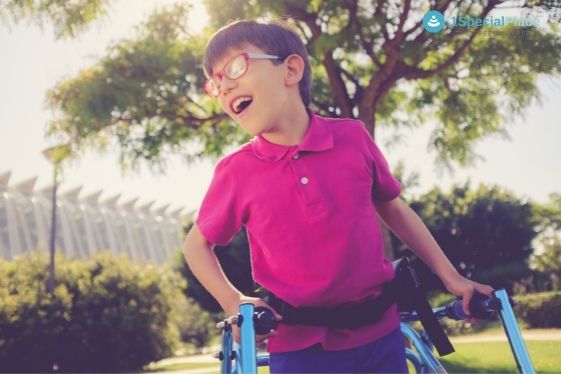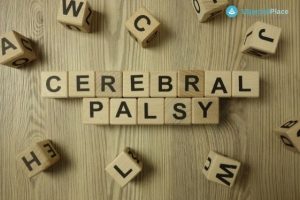What is Cerebral Palsy?
Cerebral Palsy is a condition described by a non progressive insult or malformation of the developing brain, before, at or shortly after birth that results in dysfunction of those parts of the brain that control movement. Individuals for whom the term Cerebral Palsy is used have permanent impaired functioning of their neuromotor systems acquired before the age of 3 years. They present a vast group of disorders. Some have speech difficulties, but some do not. Few have difficulty moving that they need assistance for all their activities while others can walk well and are independent in all activities. A few can move little, with their limbs held in stiff postures, while others move a lot with wriggling abnormal movements that they can’t control. Some have mental retardation, but some others have advanced learning skills.
What are the causes of Cerebral Palsy?
Despite the superb level of sophistication of health care for pregnancy and birth, it still is impossible to delineate the exact cause of the many cases of early brain damage that lead to dysfunction of the neuromotor systems. There are many prenatal, natal and post natal conditions that can cause insult to the delicate brain of a foetus.
- The developing brain is most susceptible to damage during the stages of rapid development of the neural mechanisms. A blood brain barrier that protects the brain from infections from the mother develops during the first trimester of pregnancy. The brain is prone to infections during this period. Hence any serious infections to the mother during this time can propose a threat to the foetus’s brain.
- Anoxia ( lack of oxygen) to the developing brain can cause serious damage to the delicate neuronal tissues.
- Haemorrhage or rupture of the vascular system that carries oxygenated blood to and from the developing brain is a cause for early brain insults.
- Children born with AIDS ( Auto immunodeficiency syndrome) or HIV(human immunodeficiency virus)are at a high risk of being born with brain dysfunction.
- Injestion of drugs or toxic chemicals by the mother during pregnancy can also result in insult to the developing brain.
- Trauma to the brain during birth.
- Premature birth resulting in respiratory dysfunction can cause anoxia to the brain tissues and can result in damage to the brain tissues.
- Premature birth causing kernicterus ( high concentration of bilirubin in the blood) can result in damage of the neuromotor connections of the delicate brain.
Most common causes of cerebral palsy are haemorrhage and anoxia from various causes.
What are the signs and symptoms of Cerebral Palsy?
There are some signs that may indicate a child has cerebral palsy. Not all signs are visible at birth and may become more obvious as babies develop.
Babies
- Low muscle tone (baby feels ‘floppy’ when picked up)
- Unable to hold up its own head while lying on their stomach or in a supported sitting position
- Muscle spasms or feeling stiff
- Poor muscle control, reflexes and posture
- Delayed development (can’t sit up or independently roll over by 6 months)
- Feeding or swallowing difficulties
- Preference to use one side of their body
Toddlers/Children
Although the brain of toddlers/children with cerebral palsy remains injured, the injury does not get worse as they develop.
Depending on the level of severity of their cerebral palsy, toddlers and children may experience difficulties with their physical development such as:
- not walking by 12-18 months
- not speaking simple sentences by 24 months
What are the types of CP?
There can be varied symptoms of CP. Depending on the type of Cerebral Plasy, the signs symptoms and effects change.
There are three mostly recognized types of Cerebral Palsy which are Spasticity, Athetosis and Ataxia. Symptoms like rigidity, tremor and flaccidity also might occur in these types.
Spasticity
Spasticity is the paralysis due to simultaneous contraction of reciprocal muscle groups along with hypertonicity of those muscles. It is due to an injury in the pyramidal nerve tracts and is the most common type of CP.
The muscles over contract, they pull too hard and very suddenly. Small input triggers major contraction of the muscles. A spastic child who tries to move his finger might jerk his hand and also his trunk due to the over contracted muscles. Scissor gait ( a typical manner of walking) can be present. Hands may be curled up along the wrists in contraction, or the entire arm may be pulled backward and upward along the neck. Faulty breathing is observed as there is excessive tension of the thorax and abdominal muscles.
Effects on Speech – Speech occurs in breaks and unnatural pauses due to the improper breathing. Due to the absence of smooth and gradual movements, spastic speech is often explosive. Hard articulatory contacts are seen. Speech sounds that involve complex coordinations are defective, and tongue tip sounds are very difficult. If facial paralysis is present, the lip sounds are quite difficult. Diadochokinetic rate which reflects tongue lifting might indicate the number of articulation errors present.
Athetosis
Also called as Dyskinesia, this type of CP is caused due to damage to the relay stations located deep inside the brain. It is described by involuntary writhing contractions affecting one muscle after the other. Such contractions can be fast or slow. Head may swing from side to side. Arm may shake rhythmically. Jaw and facial muscles may have repetitive grimaces, and in some affected individuals they may disappear in sleep or under the effect of alcohol. Breathing, hearing and vision problems are common.Two types of athetoid CP are recognized
Non tension athetosis
Tension Athetosis. This is confused with Spasticity. To distinguish, move the person’s arm against his resistance. In athetoid CP the arm may yield gradually but in spasticity it will release with a jerk
Effect on Speech –
Speech is soft.(poor loudness). Final sounds and final words are often whispered. Monotonous speech can be present. Articulation errors are present. Very fine sounds and those that involve tongue tip movement are most difficult.
Ataxia
It results due to an injury in the cerebellum and is a rare condition. Individuals with Ataxia have low muscle tone and find it hard to carry out complex activities like walking, writing and speaking etc in a smooth and integrated manner.
Effect on speech – Slow, slurred and arythmic speech. Misarticulations are present.
Mixed Type
Individuals who show a combination of symptoms of spasticity and athetosis fall under the mixed type of CP.
CP is also classified in terms of how much of the body is affected.
- Monoplegia – one limb is affected,
- Hemiplegia – if half of the body is affected (either right or left)
- Diplegia – involvement of both upper or both lower limbs
- Quadriplegia – spasticity or athetosis of all four limbs.
What are the treatment options for children diagnosed with CP?
Depending on the symptoms of CP, intervention and help vary from one child to the other.
Interventions for movement issues
-
Medication
Medical specialists may prescribe medications that assist movement issues. Some medications are taken orally (e.g. diazepam) and others are injected or delivered through surgically implanted pumps (e.g. Baclofen). Many children with cerebral palsy benefit from Botulinum toxin type A injections into muscles affected by spasticity. This intervention is used from about two years of age and is most effective when used in conjunction with therapy.
-
Surgical procedures
Selective Dorsal Rhizotomy (SDR) is a neurosurgical procedure that is used in a small percentage of children with cerebral palsy to permanently reduce spasticity in their legs.
-
Physiotherapy and occupational therapy
Physiotherapists and occupational therapists focus on encouraging a person’s day-to-day movement skills such as sitting, walking, playing, dressing and toileting. They will use a range of specialist interventions such as movement training and equipment, e.g. walking frames, wheelchairs, supportive seating, footwear and orthotics.
Interventions for muscle, bone and joint issues
-
Surgical procedures
Orthopaedic surgeons correct joint deformities and lengthen muscles. Surgery usually takes place in a child’s late primary years or early adolescence to improve walking quality and reduce pain. Paediatric rehabilitation specialists support the management of some of the conditions associated with cerebral palsy, such as spasticity, musculoskeletal issues and growth.
Casts, splints and muscle strengthening
Physiotherapists and occupational therapists may also focus on preventing impairments that might affect movement. They use casts, orthotics and muscle strengthening exercises.
Interventions for communication issues
Speech pathology
Speech pathologists assess and provide intervention for communication skills. Treatment (intervention) for communication often involves the use of augmentative or alternative communication systems, such as signing, communication boards and speech generating devices.
Interventions for intellectual disability and learning difficulties
Assessments, special education and learning strategies
Psychologists can provide assessment of a child’s learning and development. Special educators work with families to develop a program of interventions to address each child’s learning needs. Occupational therapists can facilitate a child’s active participation in these learning activities.
Psychologists and occupational therapists can provide assessment and recommend learning strategies to compensate for perceptual difficulties.
Interventions for epilepsy
Medication
Medical specialists may prescribe antiepileptic medication to minimise the number of seizures. They will also guide families on the management of seizures when they do occur.
Interventions for pain management
-
Medication -
Pain may be treated through medication and by addressing the underlying cause of the pain, e.g. by treating muscle contractures.
-
Cognitive-behavioural therapy-
Psychologists may offer cognitive-behavioural therapy for chronic pain. This process works to help a person change the way they think about pain and, in turn, how they feel and behave about pain.
-
Massage therapy and hydrotherapy -
Temporary relief of pain may be assisted through massage or hydrotherapy
Interventions for sleep disorders
- Medication - Medical specialists may prescribe medication or treat the associated issues that impact on sleep.
- Behaviour therapy- Psychologists may assist with behaviour therapy or help families to establish routines to help resolve children’s sleep issues.
- Sleep systems- For children with postural issues that make sleep difficult, occupational therapists and physiotherapists may prescribe special sleep systems to help children feel more comfortable in bed.
Related video: Oral Motor Exercises for Children
Interventions for behaviour and emotional issues
Behaviour therapy and counselling
Psychologists can offer assessment and support for emotional and behavioural challenges, which may include behaviour therapy and cognitive behaviour therapy. Social workers support people with cerebral palsy and their families in many ways, including strengths-based counselling and mutual aid groupwork.
Interventions for issues with eating, digestion and nutrition
Medication and surgery
Treatment (intervention) for severe difficulties with digestion, such as gastro-oesophageal reflux (GOR) includes medications or sometimes surgery. If the individual has severely limited eating skills or experiences an unsafe swallow, non-oral feeding may be recommended. This involves a surgically inserted feeding tube to the stomach or the small intestine.
Speech Pathology and Dietary Advice
Speech pathologists provide assessment and treatment (intervention) for eating, drinking and swallowing difficulties. Examples of these are learning to use the muscles of the mouth better, using specially designed utensils and sitting in an optimal position.
Dietitians provide advice on improved and balanced nutrition.
Interventions for issues with saliva control (DRIBBLING AND DROOLING)
Speech pathology
Speech pathologists may suggest various strategies to help people manage saliva loss. These include remembering to wipe their mouth and wearing age-appropriate clothing protection.
They may also recommend special exercises for the face and mouth, which may lead to better ability to control saliva.
Medication
Medical specialists may prescribe medication for saliva control. This is not usually considered a long term treatment option, but can be useful to dry up saliva temporarily. Botulinum Toxin Type A, injected into the salivary glands has also shown to reduce the secretion of saliva. In severe cases of drooling, surgery may be suggested to permanently manage saliva.


